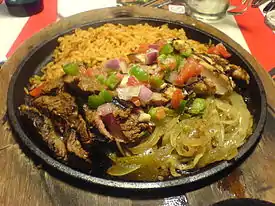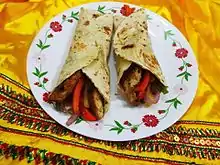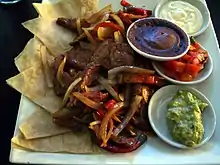Fajita
A fajita (/fəˈhiːtə/; Spanish: [faˈxita] (![]() listen)) in Tex-Mex is any grilled meat that is usually served as a taco on a flour or corn tortilla.[2] The term originally referred to skirt steak, the cut of beef first used in the dish.[3] Popular meats used include chicken and other cuts of beef, as well as vegetables instead of meat.[4][5] In restaurants, the meat is usually cooked with onions and bell peppers. Popular condiments include shredded lettuce, sour cream, guacamole, salsa, pico de gallo, shredded cheese, refried beans, and diced tomatoes. Arrachera is a northern Mexican variant of the dish.
listen)) in Tex-Mex is any grilled meat that is usually served as a taco on a flour or corn tortilla.[2] The term originally referred to skirt steak, the cut of beef first used in the dish.[3] Popular meats used include chicken and other cuts of beef, as well as vegetables instead of meat.[4][5] In restaurants, the meat is usually cooked with onions and bell peppers. Popular condiments include shredded lettuce, sour cream, guacamole, salsa, pico de gallo, shredded cheese, refried beans, and diced tomatoes. Arrachera is a northern Mexican variant of the dish.
 Mixed beef and chicken fajita ingredients, served on a hot iron skillet | |
| Place of origin | Mexico and United States |
|---|---|
| Region or state | Texas, Northeastern Mexico[1] |
| Main ingredients | Tortillas, meat, chicken, cheddar cheese, onions, peppers |
| 500 kcal | |
History


Fajita is a Tex-Mex, Texan-Mexican American or Tejano, diminutive term for little strips of meat cut from the beef skirt, the most common cut used to make fajitas.[3] The word fajita is not known to have appeared in print until 1971, according to the Oxford English Dictionary. (The word faja is Spanish for "strip", or "belt", from the Latin fascia, "band"[6]) Although fajita originally referred to these strips of beef skirt, fajitas now are made with a variety of fillings, such as green/red/yellow peppers, onions, chilies, and jalapeño peppers.[7]
Popularity
The first culinary evidence of the fajitas with the cut of meat, the cooking style (directly on a campfire or on a grill), and the Spanish nickname goes back as far as the 1930s in the ranch lands of South and West Texas. During cattle roundups, cows were butchered regularly to feed the hands. Throwaway items such as the hide, the head, the entrails, and meat trimmings such as the skirt were given to the Mexican cowboys called vaqueros as part of their pay. Hearty border dishes like barbacoa de cabeza (head barbecue), menudo (tripe stew), and fajitas or arracheras (grilled skirt steak) have their roots in this practice.[8] Considering the limited number of skirts per carcass and the fact the meat was not available commercially, the fajita tradition remained regional and relatively obscure for many years, probably only familiar to vaqueros, butchers, and their families.
In September 1969, Sonny Falcón, an Austin meat market manager, operated the first commercial fajita taco concession stand at a rural Dies Y Seis celebration in Kyle, Texas.[8] During that same year, Otilia Garza introduced fajitas at the Round-Up Restaurant in Pharr, Texas. Garza is credited with adding the signature sizzling plate presentation of fajitas after being served queso flameado (melted Mexican cheese) on a cast-iron plate in Acapulco.[9] In August of 2020, The Kyle city council voted to change the name of a controversially named road Rebel Drive to Fajita Drive in honor of local history of the fajita.[10]
The food was popularized by various businesses such as Ninfa's in Houston, the Hyatt Regency in Austin, and numerous restaurants in San Antonio.[2] In southern Arizona, the term was unknown except as a cut of meat until the 1990s, when Mexican fast food restaurants started using the word in their marketing. In recent years, fajitas have become popular at American casual dining restaurants as well as in home cooking.
In many restaurants, the fajita meat and vegetables is brought to the table sizzling loudly on a metal platter or skillet, along with warmed tortillas and condiments such as guacamole, pico de gallo, queso, salsa, shredded cheese, and/or sour cream.
References
- Patterson, Frank (2003-10-14), Fajita, archived from the original on September 24, 2008, retrieved 2013-11-06
- Wood, Virginia B. (2005-03-04). "Fajita History". The Austin Chronicle. Retrieved 2010-01-11.
- Wood, Virginia B. (2005-03-04). "Just Exactly What Is a Fajita?". The Austin Chronicle.
- Jamison, Cheryl; Jamison, Bill (2014). Rancho de Chimayo Cookbook: The Traditional Cooking of New Mexico. Rowman & Littlefield. ISBN 9781493009206.
- Butel, Jane (1994). Jane Butel's Southwestern Kitchen. Penguin. ISBN 9781557880901.
- Ayto, John (2012). The Diner's Dictionary: Word Origins of Food and Drink. Oxford: Oxford University Press. p. 130. ISBN 9780199640249. OCLC 840919592. Retrieved 2015-06-05.
fajitas.
- Fain, Lisa (2014). "Chicken Fajitas". The Homesick Texan's Family Table: Lone Star Cooking from My Kitchen to Yours. Ten Speed Press.
And then there's the language purist inside of me, who knows that calling something "chicken fajitas" is simply wrong; the word fajitas originally referred to a cut of beef. Naming the dish chicken fajitas is like saying it's "steak-sliced chicken." Of course, this battle was lost long ago.
- Wood, Virginia B.; Fri.; March 4; 2005. "Fajita History". www.austinchronicle.com. Retrieved 2019-08-27.CS1 maint: numeric names: authors list (link)
- "Low Steaks". Texas Monthly. 1993-03-01. Retrieved 2019-08-27.
- "Hays CISD to recommend to school board name change for 'Rebel' mascot". KXAN Austin. 2020-07-06. Retrieved 2020-08-19.
